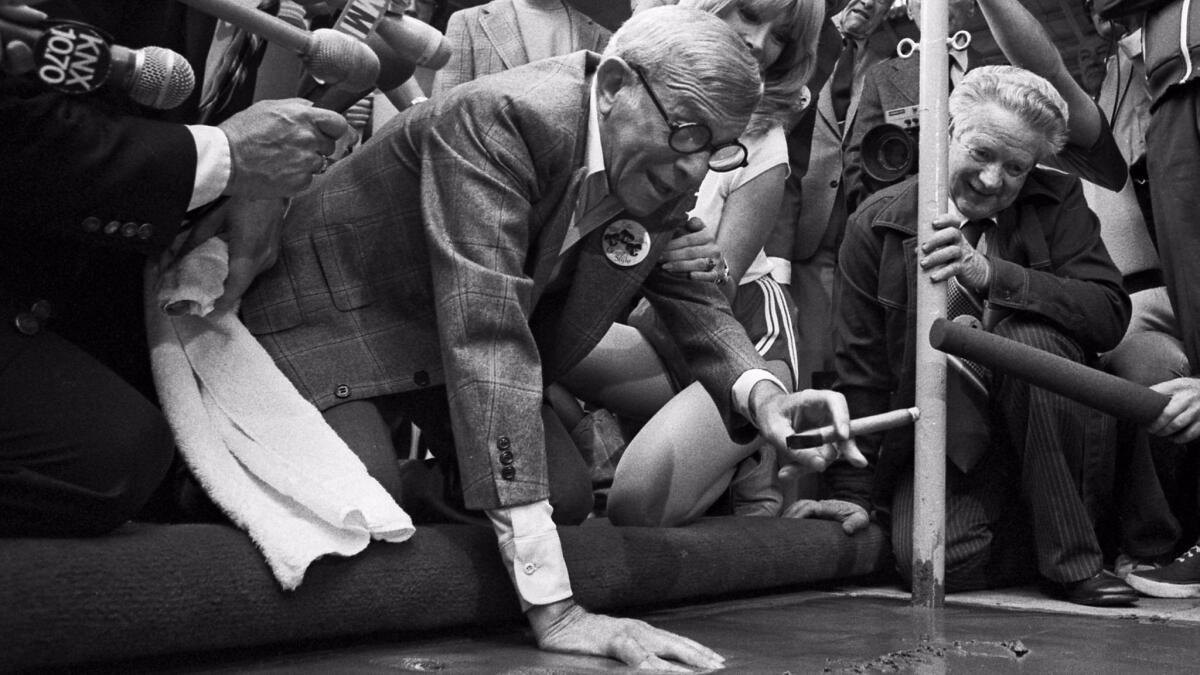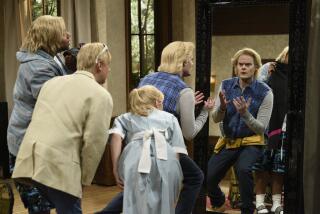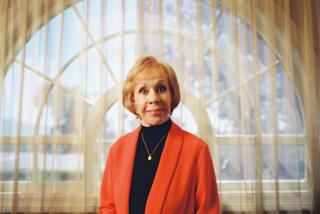From the Archives: George Burns, Comedy’s Elder Statesman, Dies
George Burns—the indefatigable entertainer whose staying power became the last, most endearing gag in a graceful, laugh-filled career—died Saturday morning at his home in Beverly Hills. He was 100 years and 49 days old.
The comedian, actor, singer and author apparently died of heart failure a few hours after his nurse found him shaking and breathing shallowly in his bed. His son, Ronnie, was with him at the end.
There were no last-second one-liners or pithy sign-offs, said Burns’ longtime manager and friend, Irving Fein. But for years, Burns had insisted in a gravelly monotone: “I don’t believe in dying. . . . It’s been done.”
Condolences poured into the Burns home from around the nation, recalling the comedian’s many incarnations—as the vaudevillian, the hit radio and television act with his beloved wife, Gracie Allen, and the irascible elder statesman of comedy.
In a statement, President Clinton called Burns “one of the great entertainers of all time,” adding: “George Burns’ sense of timing and captivating smile touched the hearts and funny bones of more than three generations. He enabled us to see humor in the toughest of times and laugh together as a nation.”
Burns’ friend of nearly eight decades, comedian Milton Berle said: “He’s up there in heaven with Gracie, doing their act. And if I know George, he’ll be throwing one-liners at St. Peter.”
Burns had been in ill health since July 1994, when he slipped and fell in the shower at his home in Las Vegas. His frailty caused him to cancel performances celebrating
his centenary at the London Palladium and Caesars Palace in Las Vegas. He was also too ill with the flu to attend his 100th birthday bash in January.
Burns will be interred alongside Allen at a private funeral service Tuesday at Forest Lawn cemetery in Glendale, Fein said. A public memorial may be scheduled later.
In the raw and cynical world of many of today’s performers, Burns was a cheerful and reassuring anachronism—whose silly songs and arid one-liners often targeted his own foibles and his legendary affinity for a pretty girl, a stiff drink and a good cigar.
Into his final days, Burns was still attending his regular bridge game at Hillcrest Country Club near Beverly Hills and talking vaguely with Fein about another comeback. He was tickled that his last of several books—”100 Years, 100 Stories”—was atop the bestseller list.
‘Love What You Do’
As much as he became an institution in his final decades, there are few who recall that Burns had come up as a struggling performer on the vaudeville circuit. He began the century singing for pennies on New York street corners. He nearly ended the century wisecracking on compact disc and playing, by satellite, to audiences worldwide.
“It’s been hard to imagine show business before George Burns,” said Bob Hope, who now, at 92, becomes comedy’s elder statesman. “Now, it’s difficult to imagine show business without him. . . . This is once when 100 years seems so short a time.”
Burns often said none of his success would have been possible without Allen, even though his career took on even greater dimensions after her death in 1964.
With his raspish voice, thick glasses and ever-present cigar, he joked about his age and his singing—often interspersing the gags among lines of some obscure song such as “If You Talk in Your Sleep, Don’t Mention My Name.”
When 1,500 people attended his 85th birthday party in the Grand Ballroom of the Beverly Hilton on Jan. 20, 1981, Burns repeated one of his familiar observations: “I’m asked how I lived to be 85 and all I can say is: I drink martinis, smoke cigars and dance very close.”
His 90th birthday party in January 1986 featured President Ronald Reagan and Frank Sinatra and, of course, Burns, who told a national television audience: “I’m gonna stay in show business until I’m the only one left.”
Burns seemed bent on that goal. At 95, he signed a five-year contract to continue his popular appearances at the Las Vegas Riviera; his planned 100th birthday shows were sold out a decade in advance. At 98, while recovering from surgery to drain fluid from his brain, he was reportedly asked what his doctor thought of his drinking and smoking.
“He’s dead,” Burns quipped from his hospital bed.
He was always busy, noting that the older he got the more he seemed to do. “The main thing,” he advised, “is to get a job and love what you do. That keeps you young. I was old at 27, because I wasn’t working. Now I’m young.”
Even in his 90s, Burns spent a couple of hours every morning working with his secretary and a writer at his office on Las Palmas Avenue. Then he drove to Hillcrest for lunch at the “Round Table” of comedians and actors. These often included Berle and—until they died—Danny Thomas, Groucho Marx, George Jessel and Burns’ close friend of more than half a century, Jack Benny.
Even in such stellar company, Berle said, Burns stole the show—day after day after day. “There wasn’t anybody funnier at the Round Table. We had the Marx Brothers, Danny Kaye, all the heavyweights. [Burns] was the hippest and the funniest.”
Then there was an hour or two of playing bridge, his favorite recreation, before he went home for a nap. After that, he often had a martini and perhaps a dinner date with some beautiful young woman.
“Burns” was only one of various names he assumed during a lifetime in show business. He was born Nathan Birnbaum on the Lower East Side of New York City on Jan. 20, 1896, into a family of seven girls and five boys.
He wrote in his first book, “I Love Her, That’s Why!” that at age 5 he was already dancing around the organ grinder who worked the neighborhood.
When he was 7, his father died and Burns tried to help the family, selling newspapers, shining shoes and, he later told an interviewer, dabbling in such petty hustles as stealing empty seltzer bottles and melting the lead tops for resale. With three other boys on the block, he formed the Peewee Quartet, a roving band of singers that performed for spare change on street corners and on the Staten Island Ferry. “We’d clear 30, 35 cents a day,” he later recalled. “Big money, but no broads.”
His mother worried that he’d end up a gangster, and, in fact, one member of the Peewee Quartet eventually became involved in organized crime and wound up in the electric chair. But performing for an audience was all that mattered to Burns. He never did well in school and often played hooky to sing in some saloon. By the fourth grade, he had dropped out.
Vaudeville Beginnings
When he was 13, he was offered $10 a week by a vaudevillian named Mac Fry to work in an act in which he would portray a poor but honest office boy. When he told his mother, she objected, pointing out that his education should come first.
“But Mama,” he said, “10 dollars!”
“All right,” she relented. “So you’ll get smart a week later.”
The act was so bad it folded after one performance.
The boy then joined another young performer to do soft-shoe dancing and fancy roller skating as Brown and Williams. At 16, he began smoking cigars to look like an actor—and never gave them up, at one time puffing his way through 20 El Productos a day, but eventually cutting down to five.
One day, as a booking agent came looking for a monologuist named George Burns, he jumped up and said, “I’m George Burns.” That got him a job at the Myrtle Theater in Brooklyn; three days for $15.
But he was called offstage and fired after the first joke.
At 17, still practicing but rarely working, Burns taught ballroom dancing to immigrants, won money in dance contests and raced through a series of stage personas—he was Jimmy Delight, then Billy Pierce, then he worked in an act called Burns and Links. He was Links.
He married one vaudeville partner, Hannah Siegal, in part because her parents insisted the two couldn’t go on the road together otherwise. They had a 36-week road contract, which they fulfilled before returning to New York and ending the act, and the marriage.
Then a jobless, 17-year-old Irish American dramatic actress who had been thinking about becoming a secretary ventured backstage to meet him. She was Gracie Allen.
Burns had her feed him straight lines so he could tell the jokes. But in their first performance, before an audience of only 40 people, nobody laughed at Burns’ gags. Instead, they broke up over Gracie’s questions.
Burns confessed it broke his heart to take the role of straight man, but “not being a fool, and wanting to continue smoking cigars, I got all the dumb jokes . . . switched character and gave them to Gracie.”
The secret of her success with an audience, he said, was that she always sounded sincere. The things she said seemed to make perfect sense to her:
George: Did the nurse ever drop you on your head when you were a baby?
Gracie: Oh, we couldn’t afford a nurse. My mother had to do it.
Burns and Allen
Burns and Allen began as a “disappointment act,” standing by as a last-second fill-in for performers who could not make a show. They were married in 1926.
“Looking back,” Burns subsequently wrote in another book, “Living it Up,” “I really don’t know why Gracie married me. I was already starting to lose my hair. I had a voice like a frog. I stuttered and stammered. I was a bad, small-time vaudeville actor and I was broke. I guess she must have felt sorry for me.”
They finally played the Palace and did their first radio shows in England. Back in the United States, they filled in for an ailing Fred Allen to do one of their standard routines, “Lamb Chops.” The same routine was the basis for their first movie, in 1929. A series of movies followed, as well as a weekly radio show that ran from 1932 until 1950.
In October 1950, Burns and Allen moved over to television, with a biweekly (subsequently weekly) domestic situation comedy on which Burns opened with a monologue (a precursor of a current hit, “Seinfeld”) and talked to the audience between scenes.
That offered an early glimpse of the stand-up routine he developed as a solo performer after Gracie left. He would take an occasional puff of his cigar and sing lines from songs he never finished.
On June 4, 1958, Burns recalled in “Living it Up,” “the last episode of the ‘Burns and Allen Show’ was filmed and Gracie retired. I didn’t blame her. She had spent all her life worrying about wardrobe, makeup, getting her hair done and rehearsals. And, after we got into television, learning 30 to 40 pages of dialogue every week.”
Now, he noted, Gracie wanted to relax and spend some time with her grandchildren. She and Burns had adopted a son, Ronnie, and a daughter, Sandra, during their years in show business.
“But I wasn’t ready to retire,” Burns wrote. “I was only 62 years old and fresh as a daisy. After all, I’d been retired all those years I was on stage with Gracie.”
It wasn’t enough for Burns that he and Gracie by that time owned the multimillion-dollar McCadden Corp. and two subsidiaries to film television shows and commercials.
He went on by himself for 26 weeks in “The George Burns Show.” That bombed. “It didn’t take a genius to figure out what was wrong,” Burns reflected later. Gracie wasn’t on it.
When the show went off the air, he realized he had to find an image for himself.
It finally occurred to him to be himself--the way he was at parties, telling amusing anecdotes and singing snatches of forgotten (for good reason) old songs. He teamed from time to time with someone such as Carol Channing, but no longer was he the straight man feeding lines to a comedienne. Somewhere along the line, he had become genuinely funny in his own right.
Gracie died in August 1964 of a heart attack. She was 58.
She and Burns were married for 38 years and he said they argued only over show business matters.
“The biggest thing in my life was meeting Gracie,” he told an interviewer later. “I don’t think I would have made it if I hadn’t met her.”
He continued to live in the big white Beverly Hills home they shared, visiting her mausoleum crypt daily at first, and then, after a time, once a month, keeping her tiny wedding ring in his pocket on a watch chain.
Widowed, he divided his days between working with his writer and kibitzing with his Hillcrest Country Club cronies.
His chief solace, he said many years later, was his work.
“You know, you cry and you cry and you cry. And finally there are no more tears. And then you go back to work,” he told an interviewer in 1989. “Every time you come home, you feel bad . . . because Gracie isn’t there.”
Yet, without her to rely on, Burns was forced to start once again from scratch, finally settling into the grandfatherly-old-scamp schtick.

George Burns makes a hand print in cement outside Mann’s Chinese Theatre on January 25, 1979.
An Oscar at 80
Still, Burns was keenly aware of the irony of the fact that it was the death of his closest pal, Jack Benny, that made him a film star late in his life.
Benny was to have starred with Walter Matthau in “The Sunshine Boys,” a film based on the old Smith and Dale vaudeville team. But Benny died as production began. Burns was so shattered by Benny’s death, he could not get through the eulogy at the funeral.
He replaced Benny in the movie, which was released in 1975 and was a hit. Although Burns had not been in a film since the 1939 MGM goofball comedy “Honolulu,” and had never played anyone but himself, he studied the script assiduously and ended up with an Oscar as best supporting actor. On the night he received the award, he was 80 years old—the oldest actor at the time ever to receive an Academy Award.
“This is all so exciting,” he said in his acceptance speech. “I’ve decided to keep making movies every 36 years. You get to be new again.”
Then he starred in “Oh, God!” with John Denver, in “Just You and Me, Kid” with Brooke Shields, “Going in Style” with Art Carney and Lee Strasberg and sequels to the film in which he got away with playing God. His stints as the Almighty later became so ingrained in the national culture that moviegoers would approach him after airplane flights and thank him for a safe trip.
He didn’t work solely for the money. By the time of Allen’s death, Burns was a wealthy man, and by the mid-1980s, he had enough money to have donated $1 million to Cedars-Sinai Medical Center and $1 million to the Motion Picture and Television Country House and Hospital in Woodland Hills. Any time a waiter, a security guard or a bellboy would show him a special courtesy or do him a favor, he would turn to his longtime manager, Fein, and say, “Irving, take care of them,” and walk away as Fein peeled bills off a thick roll of cash.
To his death he remained the single-minded performer who had achieved what he set out to do.
In recalling the early days in which he was so bad, he’d say, “I’d go to a theater under one name and get fired after the first show. In a week or two I’d be back at the same fleabag with a different name and in blackface.”
He said, “I got the hook a lot. But I’d rather be a flop in a business I love than a success in felt hats. . . . All I wanted was to be in show business.”
Times staff writers James Rainey and Eric Slater contributed to this story.
From the Archives: Milton Berle, 93; Legendary Comic Trouper Dies
From the Archives: Walter Matthau, An Expert Actor Perfected Grumpy, Rumpled Roles
From the Archives: Novelist Ernest Hemingway Dies of Gun Wounds
From the Archives: Fred Astaire, Movies’ Greatest Dancer, Dies
From the Archives: Ella Fitzgerald, Jazz’s First Lady of Song, Dies
More to Read
Start your day right
Sign up for Essential California for the L.A. Times biggest news, features and recommendations in your inbox six days a week.
You may occasionally receive promotional content from the Los Angeles Times.






